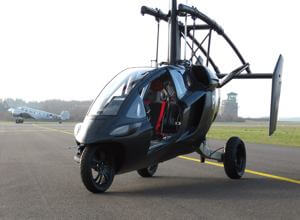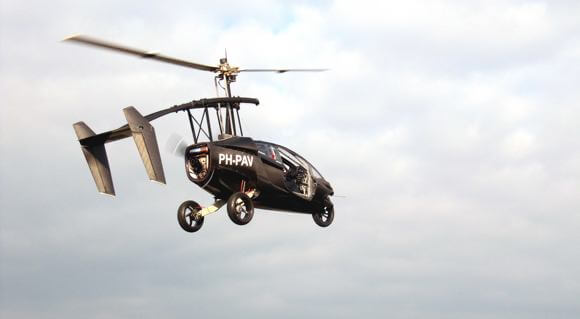
Every kid – at least the ones that grow up and read sites like Singularity Hub – dreams of flying cars. Thankfully several companies are doing their best to make sure our Jetsonsonian flying metropolis becomes a reality. PAL-V ONE is one Dutch company’s solution. A hybrid between a two seat car and a gyroplane, the PAL-V ONE is relatively easy to fly, and having completed its maiden voyage this past March, it could very well be the first land-air transport to reroute our daily travels to the skies.
The PAL-V (Personal Air and Land Vehicle) ONE is made by the Dutch company PAL-V Europe NV. Founded in 2001, the company has been rolling out prototypes since 2008, and just this past March scored with PAL-V’s maiden flight. With its small, aerodynamic cab, folded rotors, and large tail fins, the PAL-V looks more like a gyrocopter that drives rather than a car that flies – but this will be a minor consideration when viewing beltway gridlock from above.
According to the company, driving the 3-wheeled, 680 kg (1500 lbs) vehicle on land is much like driving a motorcycle, due to a patented ‘tilting’ system that automatically tilts the vehicle according to speed and turn angle.
PAL-V prototypes have thus far taken off, like fellow flying vehicles, from airports. Just 165 meters (540 feet) are needed for takeoff, and it can takeoff from a paved surface or even grass, and the rotor and rear propeller take only a few minutes to unfold. After landing, the rotors and propellers take about 10 minutes to fold back into driving position.
The company claims that it flies much quieter than a helicopter due to slower rotation of the autorotors and the slower speeds it needs during takeoff and landing. The PAL-V’s flight range is between 350 to 500 kilometers (220 to 315 miles) depending on the type of vehicle, wind conditions and payload. Driving range is about 1200 kilometers (750 miles) and its top speed on both land and in the air is about 180 kph (110 mph). Current models are fueled by gasoline, but future models will also run on biodiesel or bio-ethanol.

A main requirement for PAL-V Europe NV was to create a land-air vehicle that anyone – not just seasoned pilots – could use. This makes converting a gyrocopter, a common flying vehicle for hobbyists, into a roadster a much more feasible alternative than, say, putting wings on a DeLorean. As with other gyroplanes, the autorotors aren’t powered but require wind to rotate. This means, according to the company, that the PAL-V can be guided to a safe landing even if it stalls due to auto-rotors that “keep auto rotating.” The company has created a 3D simulator so people can practice take-offs, landings, steering, etc. before getting behind the stick of the real thing. They even simulate many real airports around the world that people might take off from. To facilitate its road and air readiness, the forward-thinking company built the car so to conform to existing international regulations for both flying and driving. It’s intended to be flown below 1,200 meters (4,000 feet), the uncontrolled airspace that hanggliders occupy.
And the PAL-V isn’t just intended for those with killer commutes. The company envisions professionals will also benefit from taking to the sky, such as police and border control, courier services, even “flying doctors.”
The PAL-V ONE is actually competing with several other cars with flying aspirations. The Terrafugia Transition, which better fits an imagined car-plane with its folding wings, was an early hopeful for air-readyness when it was given special treatment by the Federal Aviation Administration. But after being dogged by a number of setbacks, the Transition has bounced back. While being showcased at a New York auto show this past April Terrafugia announced that their prized car-plane will be commercially available by the end of the year. “Available” is a relative term, as the anticipated cost of the Transition is $279,000. Its 15 km/l (35 mpg) just edges PAL-V ONE’s 12 km/l (28 mpg). But its max takeoff weight of 650 kg (1430 lbs) falls significantly short of PAL-V ONE’s 910 kg (2006 lbs). You’ll pay for that extra performance for a PAL-V ONE with its estimated price tag of about $326,000.

Just a few weeks ago another land-and-air vehicle threw its props into the mix. Taking a perhaps more feasible approach, the Trixy Zero isn’t a flying car, but a motorcycle-style gyrocopter, that took its maiden flight on June 30. As is clear from the picture, it is also a more precarious approach. If some people are nervous about being exposed on the seat of a motorcycle, chances are they won’t want to fly in an open cockpit they could potentially fall out of.
Whether it’s the PAL-V ONE, Terrafugia, Trixy Zero, or another vehicle, it seems that flying cars/motorcycles are definitely en route. PAL-V Europe NV says that governments in the United States and Europe are already preparing for a future that includes personal air traffic, laying out the infrastructure of ‘digital freeways’ that anyone with a flying car can safely use. Initial funding included a loan from the Dutch Ministry of Economic Affairs. Government support is a good indication that a flying car isn’t just some pie in the sky dream.
[image credits: PAL-V Europe NV and EAA]
images: PAL-V Europe NV and EAA
video: PalVCo



